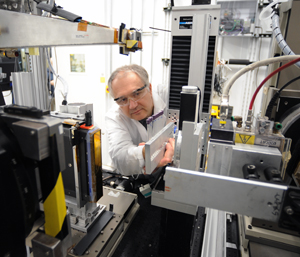
Jan Ilavsky, physicist and beamline scientist with the U.S. Department of Energy’s Advanced Photon Source (APS), has been named a Fellow of the American Crystallographic Association (ACA). Ilavsky is one of seven scientists named to the ACA Fellows class of 2021.
Ilavsky is a member of the Argonne National LaboratoryX-ray Science Division (XSD) Chemical & Materials Science Group, which operates or co-operates four x-ray beamlines at the APS.
In nominating Ilavsky for ACA Fellowship, APS users Fan Zhang and Andrew Allen (both National Institute of Standards and Technology) noted his “outstanding contributions in applied crystallography, including his seminal contributions in advancing the structure-property relationship of advanced functional materials, his global leadership in establishing a state-of-the-art x-ray scattering measurement platform and standards, developing robust and widely used scattering data reduction and analysis software packages, and his extraordinary and sustained service to the American and international crystallographic community.”
In particular, they cited his work in the areas of scattering studies of thermal barrier coatings and other technologically important materials; development of the ultra-small-angle x-ray scattering facility at the APS, as well as the Irena and Nika small-angle scattering software packages and the Small-angle X-ray Scattering Intensity Standard; and training next-generation crystallographers through educational outreach (especially as the founder of the “Beyond Rg” small-angle x-ray scattering course at the APS, which is an intermediate level, week-long course run every two years since 2007 that has trained over 750 students, postdocs, and junior scientists).
“His scholarly publications on technologically important materials [more than 290 publications and over 10,000 citations] have had significant impact,” wrote Zhang and Allen. “He led the development and built the user program for an across-length-scale scattering and diffraction instrument at the APS, enabling simultaneous, in situ structure and microstructure characterization of a multitude of functional and structural materials with hierarchical structures. The APS ultra-small-angle x-ray scattering instrument represents a major advancement in materials characterization. His small-angle scattering (SAS) data reduction and analysis software have changed how the international small-angle scattering community handles SAS data. Jan Ilavsky has certainly earned the recognition of becoming an ACA Fellow.”
“All of us are delighted with this recognition of Jan’s enormous contributions to his field,” said XSD Director Jonathan Lang. “He is a long-standing, tireless, and invaluable member of our research staff. I know his colleagues, the hundreds of APS users he has supported, and the hundreds of students who have benefitted from the knowledge he freely shares join me in congratulating Jan.”
The Advanced Photon Source is a U.S. Department of Energy (DOE) Office of Science User Facility operated for the DOE Office of Science by Argonne National Laboratory under Contract DE-AC02-06CH11357.
The U.S. Department of Energy's APS is one of the world’s most productive x-ray light source facilities. Each year, the APS provides high-brightness x-ray beams to a diverse community of more than 5,000 researchers in materials science, chemistry, condensed matter physics, the life and environmental sciences, and applied research. Researchers using the APS produce over 2,000 publications each year detailing impactful discoveries, and solve more vital biological protein structures than users of any other x-ray light source research facility. APS x-rays are ideally suited for explorations of materials and biological structures; elemental distribution; chemical, magnetic, electronic states; and a wide range of technologically important engineering systems from batteries to fuel injector sprays, all of which are the foundations of our nation’s economic, technological, and physical well-being.
Argonne National Laboratory seeks solutions to pressing national problems in science and technology. The nation's first national laboratory, Argonne conducts leading-edge basic and applied scientific research in virtually every scientific discipline. Argonne researchers work closely with researchers from hundreds of companies, universities, and federal, state and municipal agencies to help them solve their specific problems, advance America's scientific leadership and prepare the nation for a better future. With employees from more than 60 nations, Argonne is managed by UChicago Argonne, LLC, for the U.S. DOE Office of Science.
The U.S. Department of Energy's Office of Science is the single largest supporter of basic research in the physical sciences in the United States and is working to address some of the most pressing challenges of our time. For more information, visit the Office of Science website.
